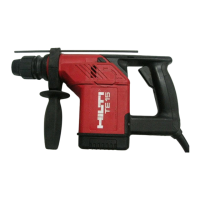Please note before
start-up:
1. The electric supply must be the same as
given on the machine nameplate.
2. This machine is double insulated and
need not be grounded (earthed).
3. Do not exert undue pressure on the ma-
chine. This will not increase its performance.
Just position the bit and guide it into the
hole.
Lubrication of chuck: The chuck is not in-
corporated in the lubricating system of
the machine. The drill bit connection end,
therefore, must be cleaned regularly and
sprayed sparingly with Hilti lubricant.
Start-up time at low temperatures: Shorten
it by jolting the drill bit once against the base
material during the start-up.
Servicing:
Electric tools comply with respective
safety regulations. Servicing must, there-
fore, be carried out only by qualified elec-
trical specialists. For your safety, only
use original Hilti repair parts.
Operating:
Fig. 1: Insertion of drill bit
Turn chuck to the left (symbol
()
). Insert
drill bit in any position until resistance is felt.
Then turn it until it moves in farther. Turn
chuck to right and lock drill bit in place (sym-
bol
()
).
Fig. 2: Rotary hammer drilling
To hammer drill into concrete, masonry and
stone, shift setting lever to indicated rotary
hammer drilling position (symbol ).
Fig. 3: Rotary drilling
Shift setting sleeve to indicated rotary drilling
position (symbol ). Only the
rotary action is transmitted to the drill bit
in this position.
Fig. 4: Changing the chuck
Pull forward sleeve and completely remove
chuck. When attaching chuck pull for-
ward sleeve and hold it there. Press chuck
onto guide tube as far as it will go. Release
sleeve. Turn chuck until steel balls snap into
place.
Note:
On attaching a keyless chuck, the hammer-
ing action is automatically cut out i. e. rotary
drilling only is obtained.
Fig. 5: Side handle/depth gauge
Unscrew side handle to release depth gauge.
Adjust depth gauge and retighten.
Double insulation
The Hilti TE15 Hammer Drill is doublein-
sulated for extra operator protection. The
tool is equipped with a two-wire cord and
two-prong plug which can be used on stan-
dard 115 volts outlets. No grounding of the
tool is necessary.
1
2
3
4
5

